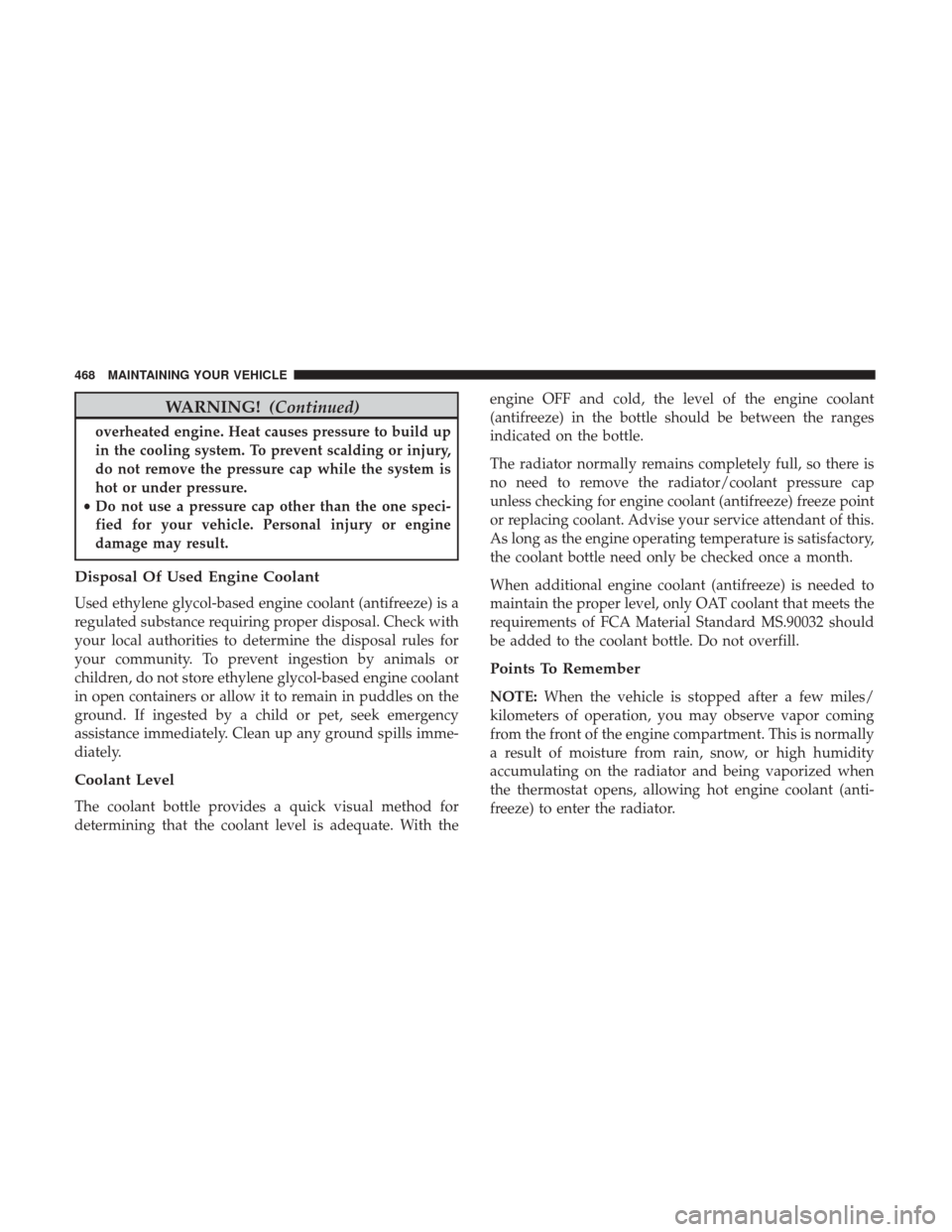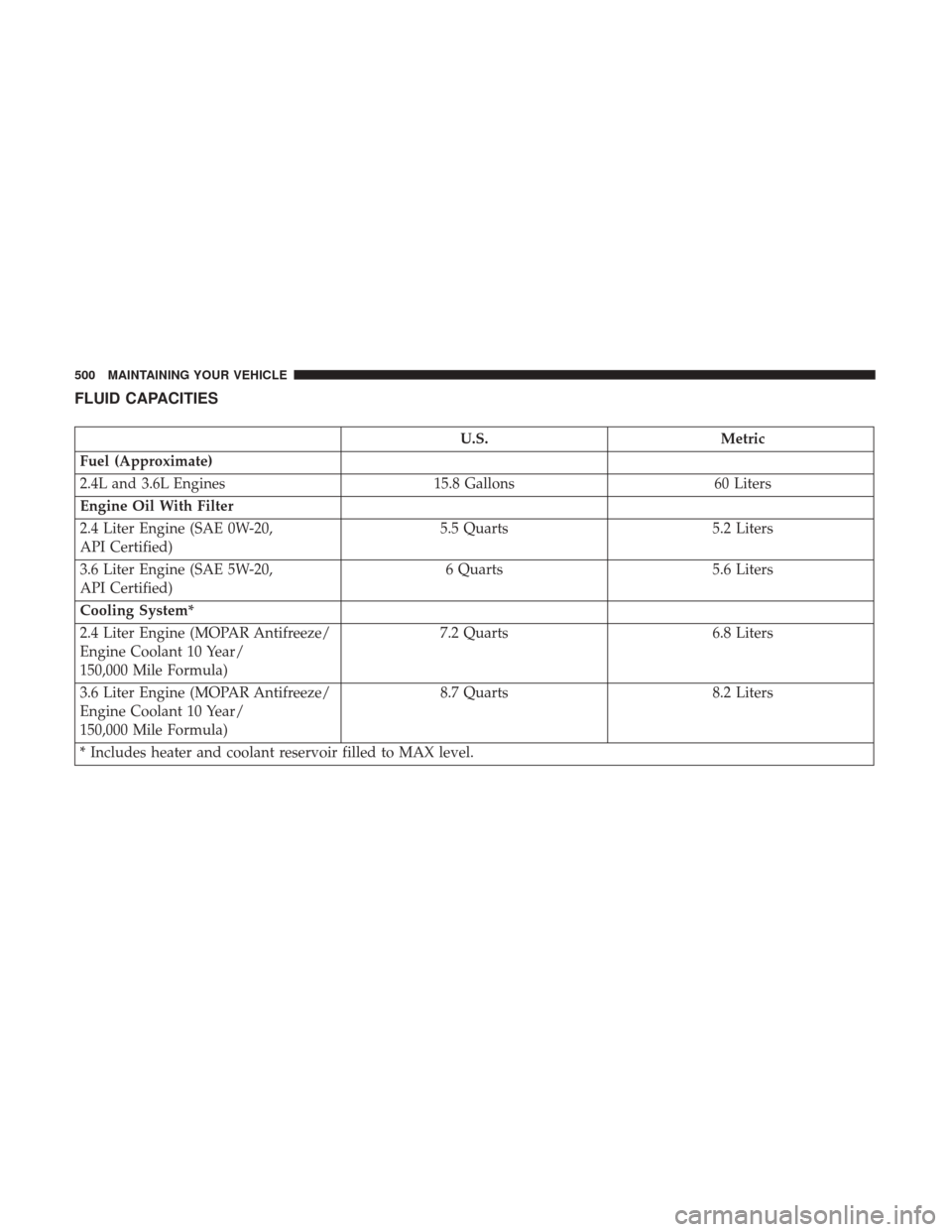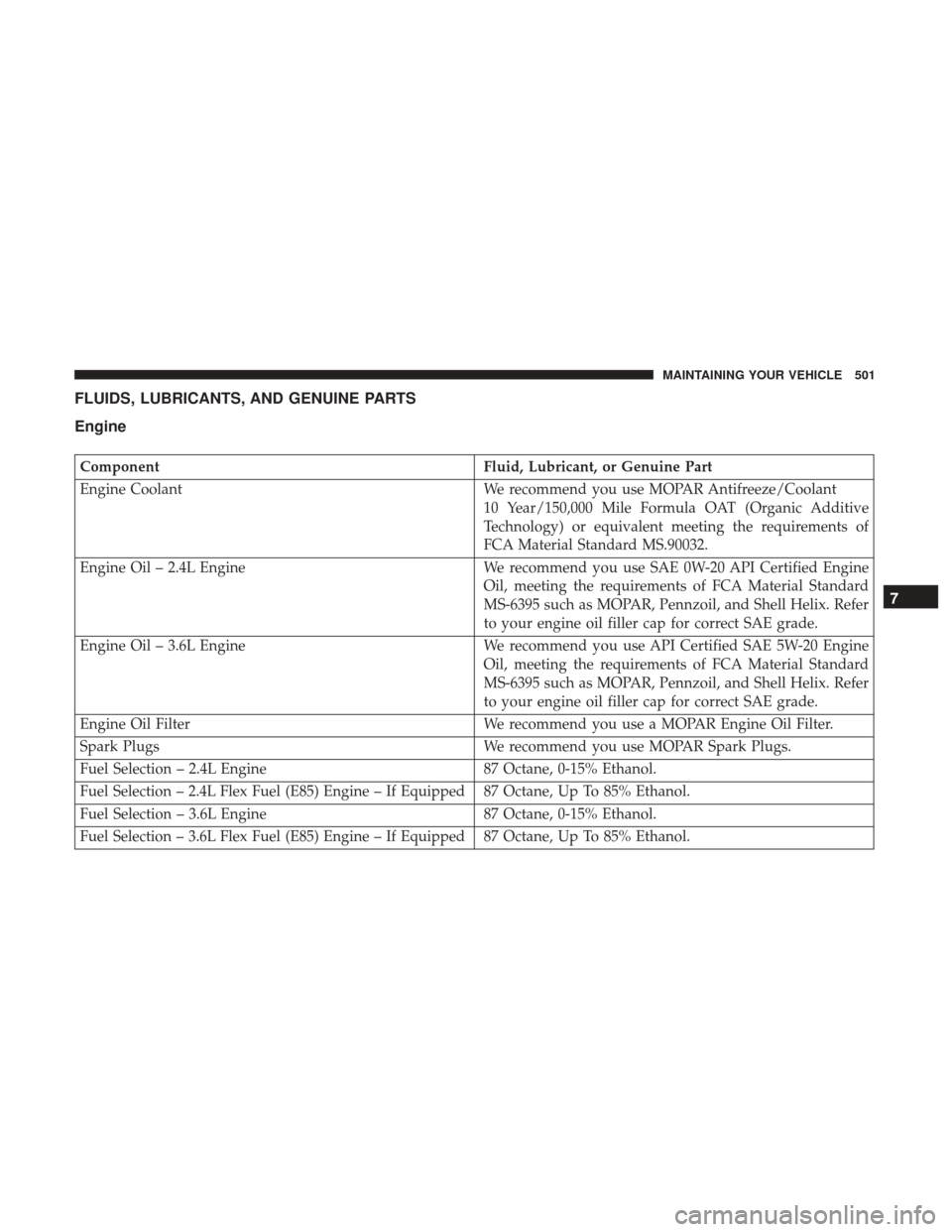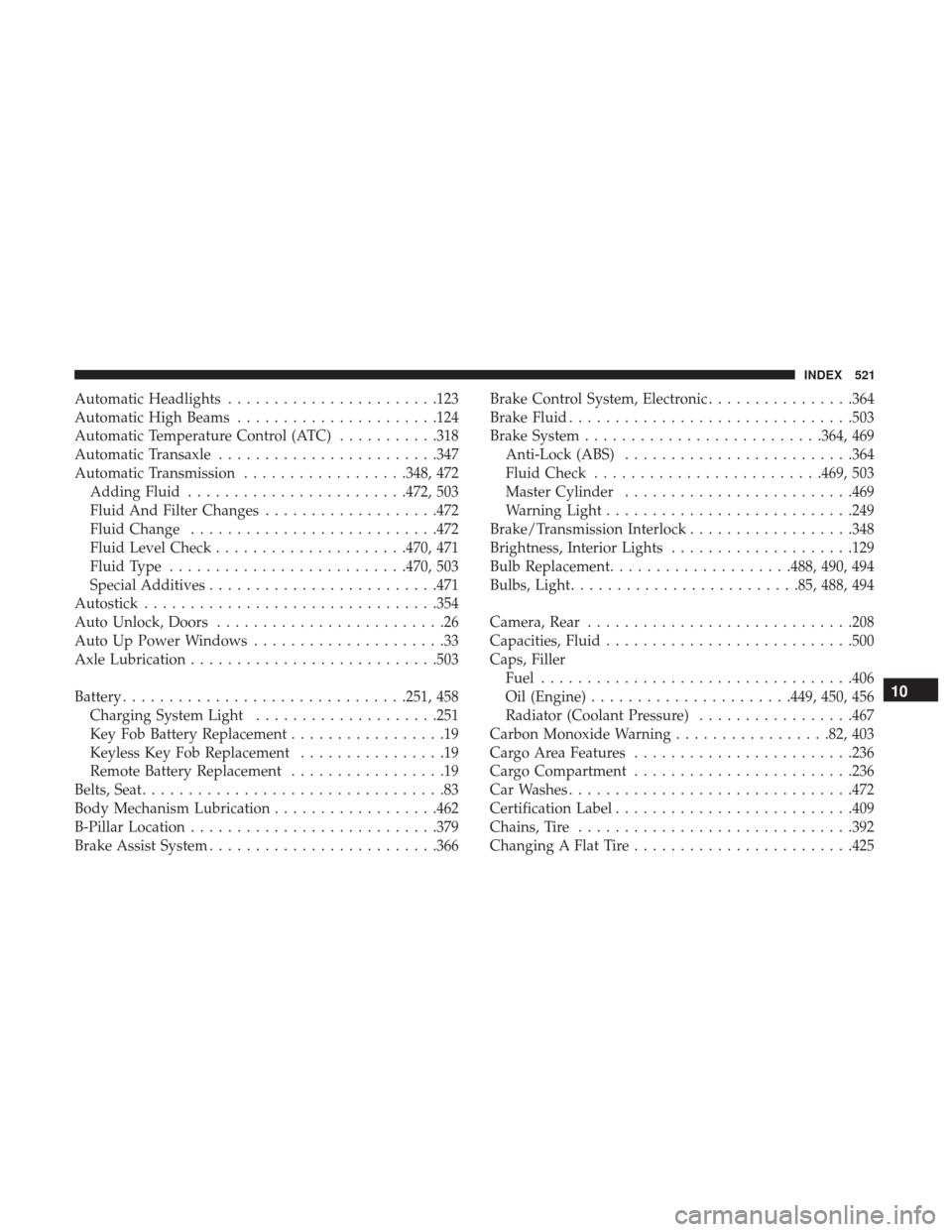engine coolant CHRYSLER 200 2017 2.G User Guide
[x] Cancel search | Manufacturer: CHRYSLER, Model Year: 2017, Model line: 200, Model: CHRYSLER 200 2017 2.GPages: 539, PDF Size: 5.18 MB
Page 469 of 539

•We recommend using MOPAR Antifreeze/Coolant
10 Year/150,000 Mile Formula OAT (Organic Additive
Technology) that meets the requirements of FCA Mate-
rial Standard MS.90032.
• Mix a minimum solution of 50% OAT engine coolant
that meets the requirements of FCA Material Standard
MS.90032 and distilled water. Use higher concentrations
(not to exceed 70%) if temperatures below �34°F (�37°C)
are anticipated. Please contact your authorized dealer
for assistance.
• Use only high purity water such as distilled or deionized
water when mixing the water/engine coolant (anti-
freeze) solution. The use of lower quality water will
reduce the amount of corrosion protection in the engine
cooling system.
NOTE:
• It is the owner’s responsibility to maintain the proper
level of protection against freezing according to the
temperatures occurring in the area where the vehicle is
operated.
• Some vehicles require special tools to add coolant prop-
erly. Failure to fill these systems properly could lead to severe internal engine damage. If any coolant is needed
to be added to the system, please contact your local
authorized dealer.
• Mixing engine coolant (antifreeze) types is not recom-
mended and can result in cooling system damage. If
HOAT and OAT coolant are mixed in an emergency,
have a authorized dealer drain, flush, and refill with
OAT coolant (conforming to MS.90032) as soon as pos-
sible.
Cooling System Pressure Cap
The cap must be fully tightened to prevent loss of engine
coolant (antifreeze), and to ensure that engine coolant
(antifreeze) will return to the radiator from the coolant
recovery tank.
The cap should be inspected and cleaned if there is any
accumulation of foreign material on the sealing surfaces.
WARNING!
• Do not open hot engine cooling system. Never add
engine coolant (antifreeze) when the engine is over-
heated. Do not loosen or remove the cap to cool an
(Continued)
7
MAINTAINING YOUR VEHICLE 467
Page 470 of 539

WARNING!(Continued)
overheated engine. Heat causes pressure to build up
in the cooling system. To prevent scalding or injury,
do not remove the pressure cap while the system is
hot or under pressure.
• Do not use a pressure cap other than the one speci-
fied for your vehicle. Personal injury or engine
damage may result.
Disposal Of Used Engine Coolant
Used ethylene glycol-based engine coolant (antifreeze) is a
regulated substance requiring proper disposal. Check with
your local authorities to determine the disposal rules for
your community. To prevent ingestion by animals or
children, do not store ethylene glycol-based engine coolant
in open containers or allow it to remain in puddles on the
ground. If ingested by a child or pet, seek emergency
assistance immediately. Clean up any ground spills imme-
diately.
Coolant Level
The coolant bottle provides a quick visual method for
determining that the coolant level is adequate. With the engine OFF and cold, the level of the engine coolant
(antifreeze) in the bottle should be between the ranges
indicated on the bottle.
The radiator normally remains completely full, so there is
no need to remove the radiator/coolant pressure cap
unless checking for engine coolant (antifreeze) freeze point
or replacing coolant. Advise your service attendant of this.
As long as the engine operating temperature is satisfactory,
the coolant bottle need only be checked once a month.
When additional engine coolant (antifreeze) is needed to
maintain the proper level, only OAT coolant that meets the
requirements of FCA Material Standard MS.90032 should
be added to the coolant bottle. Do not overfill.
Points To Remember
NOTE:
When the vehicle is stopped after a few miles/
kilometers of operation, you may observe vapor coming
from the front of the engine compartment. This is normally
a result of moisture from rain, snow, or high humidity
accumulating on the radiator and being vaporized when
the thermostat opens, allowing hot engine coolant (anti-
freeze) to enter the radiator.
468 MAINTAINING YOUR VEHICLE
Page 471 of 539

If an examination of your engine compartment shows no
evidence of radiator or hose leaks, the vehicle may be
safely driven. The vapor will soon dissipate.
•Do not overfill the coolant expansion bottle.
• Check the coolant freeze point in the radiator and in the
coolant expansion bottle. If engine coolant (antifreeze)
needs to be added, the contents of the coolant expansion
bottle must also be protected against freezing.
• If frequent engine coolant (antifreeze) additions are
required, the cooling system should be pressure tested
for leaks.
• Maintain engine coolant (antifreeze) concentration at a
minimum of 50% OAT coolant (conforming to
MS.90032) and distilled water for proper corrosion pro-
tection of your engine which contains aluminum com-
ponents.
• Make sure that the coolant expansion bottle overflow
hoses are not kinked or obstructed.
• Keep the front of the radiator clean. If your vehicle is
equipped with air conditioning, keep the front of the
condenser clean.
• Do not change the thermostat for Summer or Winter
operation. If replacement is ever necessary, install ONLY the correct type thermostat. Other designs may result in
unsatisfactory engine coolant (antifreeze) performance,
poor gas mileage, and increased emissions.
Brake System
In order to assure brake system performance, all brake
system components should be inspected periodically. Refer
to the “Maintenance Schedule” for the proper maintenance
intervals.
WARNING!
Riding the brakes can lead to brake failure and possi-
bly a collision. Driving with your foot resting or riding
on the brake pedal can result in abnormally high brake
temperatures, excessive lining wear, and possible
brake damage. You would not have your full braking
capacity in an emergency.
Brake Master Cylinder
The fluid in the master cylinder should be checked when
performing under hood services or immediately if the
“Brake Warning Light” is illuminated.
Be sure to clean the top of the master cylinder area before
removing the cap. If necessary, add fluid to bring the fluid
7
MAINTAINING YOUR VEHICLE 469
Page 502 of 539

FLUID CAPACITIES
U.S.Metric
Fuel (Approximate)
2.4L and 3.6L Engines 15.8 Gallons60 Liters
Engine Oil With Filter
2.4 Liter Engine (SAE 0W-20,
API Certified) 5.5 Quarts
5.2 Liters
3.6 Liter Engine (SAE 5W-20,
API Certified) 6 Quarts
5.6 Liters
Cooling System*
2.4 Liter Engine (MOPAR Antifreeze/
Engine Coolant 10 Year/
150,000 Mile Formula) 7.2 Quarts
6.8 Liters
3.6 Liter Engine (MOPAR Antifreeze/
Engine Coolant 10 Year/
150,000 Mile Formula) 8.7 Quarts
8.2 Liters
* Includes heater and coolant reservoir filled to MAX level.
500 MAINTAINING YOUR VEHICLE
Page 503 of 539

FLUIDS, LUBRICANTS, AND GENUINE PARTS
Engine
ComponentFluid, Lubricant, or Genuine Part
Engine Coolant We recommend you use MOPAR Antifreeze/Coolant
10 Year/150,000 Mile Formula OAT (Organic Additive
Technology) or equivalent meeting the requirements of
FCA Material Standard MS.90032.
Engine Oil – 2.4L Engine We recommend you use SAE 0W-20 API Certified Engine
Oil, meeting the requirements of FCA Material Standard
MS-6395 such as MOPAR, Pennzoil, and Shell Helix. Refer
to your engine oil filler cap for correct SAE grade.
Engine Oil – 3.6L Engine We recommend you use API Certified SAE 5W-20 Engine
Oil, meeting the requirements of FCA Material Standard
MS-6395 such as MOPAR, Pennzoil, and Shell Helix. Refer
to your engine oil filler cap for correct SAE grade.
Engine Oil Filter We recommend you use a MOPAR Engine Oil Filter.
Spark Plugs We recommend you use MOPAR Spark Plugs.
Fuel Selection – 2.4L Engine 87 Octane, 0-15% Ethanol.
Fuel Selection – 2.4L Flex Fuel (E85) Engine – If Equipped 87 Octane, Up To 85% Ethanol.
Fuel Selection – 3.6L Engine 87 Octane, 0-15% Ethanol.
Fuel Selection – 3.6L Flex Fuel (E85) Engine – If Equipped 87 Octane, Up To 85% Ethanol.
7
MAINTAINING YOUR VEHICLE 501
Page 504 of 539

CAUTION!
•Mixing of engine coolant (antifreeze) other than speci-
fied Organic Additive Technology (OAT) engine cool-
ant (antifreeze), may result in engine damage and may
decrease corrosion protection. Organic Additive Tech-
nology (OAT) engine coolant is different and should
not be mixed with Hybrid Organic Additive Technol-
ogy (HOAT) engine coolant (antifreeze) or any “glob-
ally compatible” coolant (antifreeze). If a non-OAT
engine coolant (antifreeze) is introduced into the cool-
ing system in an emergency, the cooling system will
need to be drained, flushed, and refilled with fresh
(Continued)
CAUTION! (Continued)
OAT coolant (conforming to MS.90032), by an autho-
rized dealer as soon as possible.
•Do not use water alone or alcohol-based engine
coolant (antifreeze) products. Do not use additional
rust inhibitors or antirust products, as they may not
be compatible with the radiator engine coolant and
may plug the radiator.
• This vehicle has not been designed for use with
propylene glycol-based engine coolant (antifreeze).
Use of propylene glycol-based engine coolant (anti-
freeze) is not recommended.
502 MAINTAINING YOUR VEHICLE
Page 508 of 539

MAINTENANCE SCHEDULE
Your vehicle is equipped with an automatic oil change
indicator system. The oil change indicator system will
remind you that it is time to take your vehicle in for
scheduled maintenance.
Based on engine operation conditions, the oil change
indicator message will illuminate. This means that service
is required for your vehicle. Operating conditions such as
frequent short-trips, trailer tow, extremely hot or cold
ambient temperatures will influence when the “Oil Change
Required” message is displayed. Severe Operating Condi-
tions can cause the change oil message to illuminate as
early as 3,500 miles (5,600 km) since last reset. Have your
vehicle serviced as soon as possible, within the next
500 miles (805 km).
Your authorized dealer will reset the oil change indicator
message after completing the scheduled oil change. If a
scheduled oil change is performed by someone other than
your authorized dealer, the message can be reset by
referring to the steps described under “Oil Change Reset”
in “Instrument Cluster Display” in “Understanding Your
Instrument Panel” for further information.NOTE:
Under no circumstances should oil change inter-
vals exceed 10,000 miles (16,000 km), twelve months or 350
hours of engine run time, whichever comes first. The 350
hours of engine run or idle time is generally only a concern
for fleet customers.
Severe Duty All Models
Change Engine Oil at 4,000 miles (6,500 km) if the vehicle
is operated in a dusty and off road environment or is
operated predominately at idle or only very low engine
RPM’s. This type of vehicle use is considered Severe Duty.
Once A Month Or Before A Long Trip:
• Check engine oil level.
• Check windshield washer fluid level.
• Check tire pressure and look for unusual wear or
damage. Rotate tires at the first sign of irregular wear,
even if it occurs before the oil indicator system turns on.
• Check the fluid levels of the coolant reservoir and brake
master cylinder, fill as needed.
• Check function of all interior and exterior lights.
506 MAINTENANCE SCHEDULES
Page 510 of 539

Mileage:20,000
30,000
40,000
50,000
60,000
70,000
80,000
90,000
100,000
110,000
120,000
130,000
140,000
150,000
Or Years: 2 3 4 5 6 7 8 9 10 11 12 13 14 15
Or Kilometers:
32,000
48,000
64,000
80,000
96,000
112,000
128,000
144,000
160,000
176,000
192,000
208,000
224,000
240,000
Inspect front accessory drive belt, tensioner, idler pul-
ley, and replace if necessary X
Additional Maintenance
Replace engine air cleaner filter. XX X XX
Replace air conditioning/cabin air filter. X X X X X X X
Replace spark plugs** X
Flush and replace the engine coolant at 10 years or
150,000 miles (240,000 km) whichever comes first. XX
Inspect and replace PCV valve if necessary. X
** The spark plug change interval is mileage based only,
yearly intervals do not apply.
508 MAINTENANCE SCHEDULES
Page 522 of 539

About Your Brakes........................ .364
Adaptive Cruise Control (ACC) (Cruise Control) . . . .139
Adding Engine Coolant (Antifreeze) .............466
Additives, Fuel ........................... .402
Adjust Down ................................ .109
Forward .............................. .108
Rearward ............................. .108
Up.................................. .109
AirBag ..................................48 Air Bag Operation .........................50
Air Bag Warning Light ...................51, 64
Driver Knee Air Bag .......................58
Enhanced Accident Response ..............63, 445
Event Data Recorder (EDR) .................445
FrontAirBag ............................51
If A Deployment Occurs ....................62
Knee Impact Bolsters .......................57
Maintaining Your Air Bag System ..............65
Redundant Air Bag Warning Light .............65
Side Air Bags ............................58
Transporting Pets .........................81
Air Bag Light ....................... .64, 83, 248
Air Bag Maintenance .........................65
Air Cleaner, Engine (Engine Air Cleaner Filter) ......457Air Conditioner Maintenance
..................458
Air Conditioning Filter ...................320, 459
Air Conditioning, Operating Tips ............319, 321
Air Conditioning Refrigerant ...............458, 459
Air Conditioning System ..................318, 458
Air Filter ............................... .457
Air Pressure, Tires ......................... .384
Alarm Arm The System ..........................14
Disarm The System ........................15
Rearming The System ......................14
Tamper Alert ............................16
Vehicle Security Alarm .....................14
Alarm, Panic ...............................19
Alarm (Security Alarm) ..................... .250
All Wheel Drive (AWD) ..................... .356
Alterations/Modifications, Vehicle ................6
Antifreeze (Engine Coolant) ................466, 500
Disposal .............................. .468
Anti-Lock
Brake System (ABS) .................365
Anti-Lock Warning Light .....................262
Appearance Care .......................... .472
Assist, Hill Start .......................... .367
Auto Down Power Windows ...................33
Automatic Door Locks ........................26
520 INDEX
Page 523 of 539

Automatic Headlights...................... .123
Automatic High Beams ..................... .124
Automatic Temperature Control (ATC) ...........318
Automatic Transaxle ....................... .347
Automatic Transmission ..................348, 472
Adding Fluid ....................... .472, 503
Fluid And Filter Changes ...................472
Fluid Change .......................... .472
Fluid Level Check .....................470, 471
Fluid Type ......................... .470, 503
Special Additives ........................ .471
Autostick ............................... .354
Auto Unlock, Doors .........................26
Auto Up Power Windows .....................33
Axle Lubrication .......................... .503
Battery .............................. .251, 458
Charging System Light ....................251
Key Fob Battery Replacement .................19
Keyless Key Fob Replacement ................19
Remote Battery Replacement .................19
Belts, Seat .................................83
Body Mechanism Lubrication ..................462
B-Pillar Location .......................... .379
Brake Assist System ........................ .366Brake Control System, Electronic
................364
Brake Fluid .............................. .503
Brake System ......................... .364, 469
Anti-Lock (ABS) ........................ .364
Fluid Check ........................ .469, 503
Master Cylinder ........................ .469
Warning Light .......................... .249
Brake/Transmission Interlock ..................348
Brightness, Interior Lights ....................129
Bulb Replacement ....................488, 490, 494
Bulbs, Light ........................ .85, 488, 494
Camera, Rear ............................ .208
Capacities,
Fluid .......................... .500
Caps, Filler Fuel ................................. .406
Oil (Engine) ..................... .449, 450, 456
Radiator (Coolant Pressure) .................467
Carbon Monoxide Warning .................82, 403
Cargo Area Features ....................... .236
Cargo Compartment ....................... .236
Car Washes .............................. .472
Certification Label ......................... .409
Chains, Tire ............................. .392
Changing A Flat Tire ....................... .425
10
INDEX 521